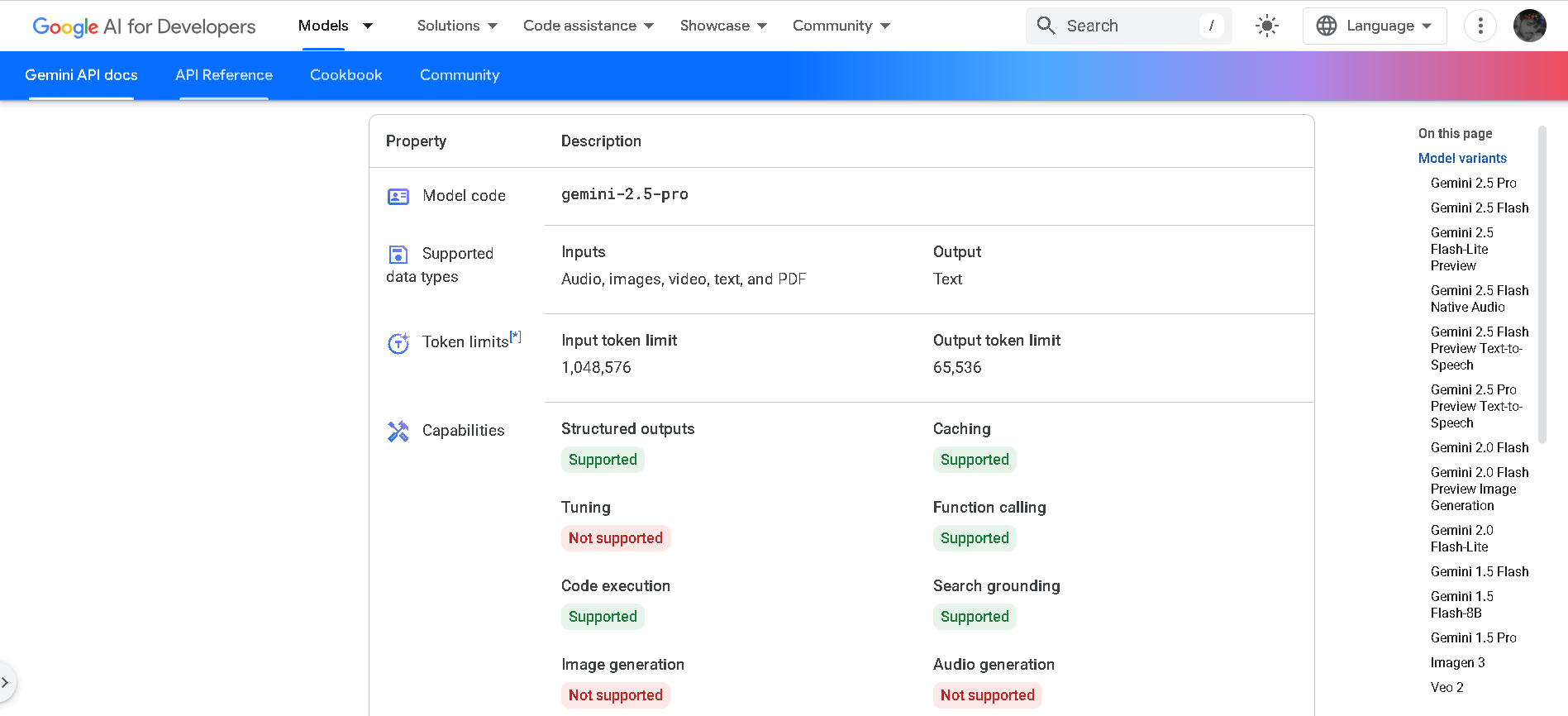
- Developers & Engineers: Build apps with long-context understanding, large-code analysis, and model-powered agents.
- Scientists & Researchers: Leverage it for math proofs, code generation, scientific discovery, and multimodal reasoning.
- Productivity Teams: Use Deep Think mode to summarize reports, analyze datasets, and generate intelligent insights.
- Enterprises & API Users: Available in Google AI Studio, Gemini Advanced ($20/month), and soon on Vertex AI with tiered API pricing.
- Content & Media Teams: Create content, transcriptions, multilingual audio outputs, and context-aware summaries at scale.
How to Use Gemini 2.5 Pro?
- Access the Model: Try it in Google AI Studio (free experimental access with rate limits), purchase Gemini Advanced plan, or use via Gemini API in Studio or Vertex AI.
- Provide Inputs: Submit text, images, audio, video, or code; model responds with detailed, context-aware output.
- Enable Deep Think: Use the Deep Think mode or configure thinking budgets in the API for step-by-step reasoning.
- Scale Usage: API supports up to 2M token context window; tiered pricing covers usage beyond thresholds.
- Integrate Securely: Deploy in production with enterprise-grade security, multilingual support, and grounding capabilities.
- True Hybrid Reasoning: Pauses to think before answering, with developer controls over compute depth.
- Massive Context Window: Handles up to 2 million tokens through API—ideal for very large documents or archives.
- Multimodal Powerhouse: Supports text, images, audio, video, and complex code workflows in one model.
- Benchmark-Setting Performance: Tops LMArena by +39 Elo, leads GPQA, AIME, Humanity’s Last Exam, and outperforms in coding benchmarks.
- Flexible Pricing Structure: Free experimental use, then $1.25–$2.50 input and $10–$15 output per million tokens; configurable thinking-token costs; add-ons like grounding and audio generation.
- Industry-leading performance in reasoning, science, and coding
- Deep Think mode offers transparent, stepwise logic
- Supports huge context windows and rich media inputs
- Reasoned, grounded output improves factual trust
- Scalable tiered pricing with free experimentation
- Initial free access limited by rate caps—may frustrate power users
- Higher-end features (context, API access) require paid plan
- Cost can accumulate for long or heavy multimodal tasks
API
Custom
- Input price: 1) $1.25, prompts <= 200k tokens 2) $2.50, prompts > 200k tokens
- Output price (including thinking tokens): 1) $10.00, prompts <= 200k tokens 2) $15.00, prompts > 200k
- Context caching price: 1) $0.31, prompts <= 200k tokens 2) $0.625, prompts > 200k 3) $4.50 / 1,000,000 tokens per hour (storage price)
- Grounding with Google Search: 1,500 RPD (free), then 1) $35 / 2) 1,000 requests
Proud of the love you're getting? Show off your AI Toolbook reviews—then invite more fans to share the love and build your credibility.
Add an AI Toolbook badge to your site—an easy way to drive followers, showcase updates, and collect reviews. It's like a mini 24/7 billboard for your AI.
Reviews
Rating Distribution
Average score
Popular Mention
FAQs
Similar AI Tools
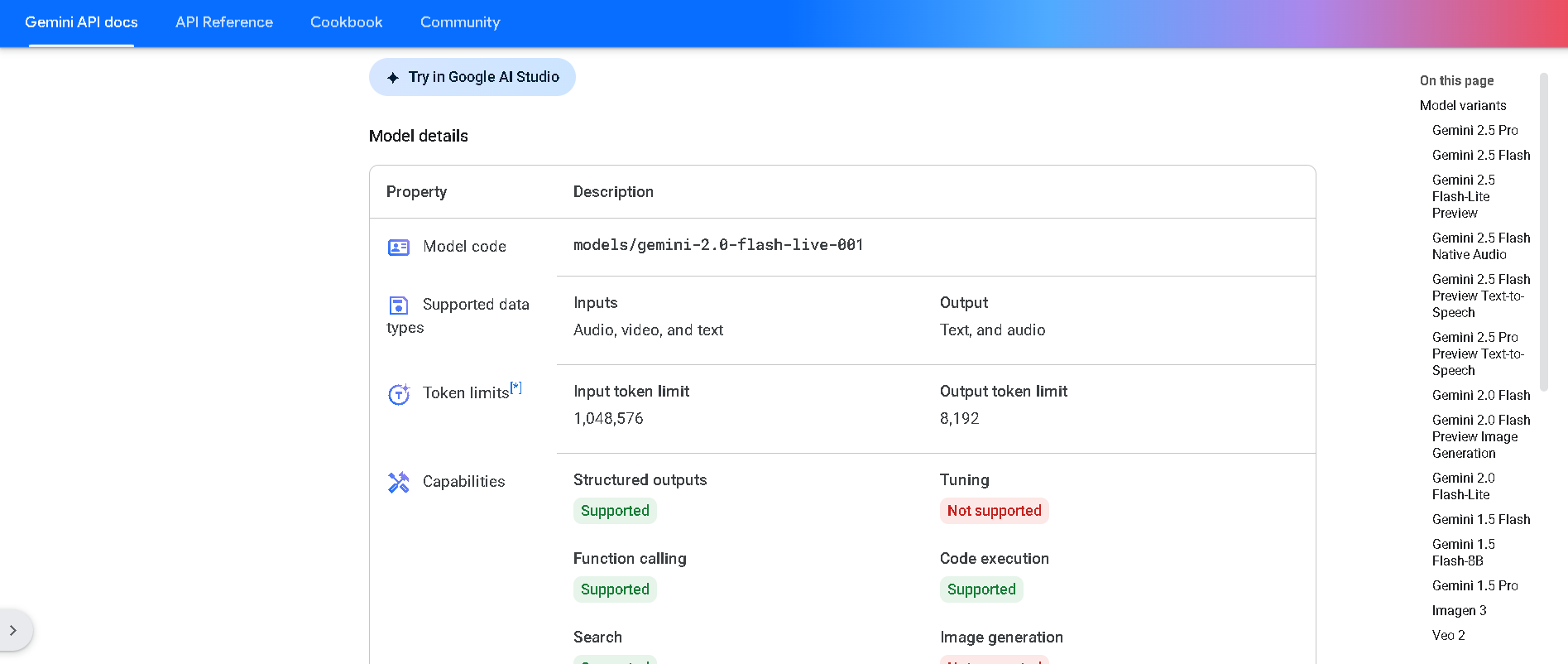
Gemini 2.0 Flash Live is Google DeepMind’s real-time, multimodal chatbot variant powered by the Live API. It supports simultaneous streaming of voice, video, and text inputs, and responds in both spoken audio and text, enabling rich, bidirectional live interactions with low latency and tool integration.


Gemini 2.0 Flash L..
Gemini 2.0 Flash Live is Google DeepMind’s real-time, multimodal chatbot variant powered by the Live API. It supports simultaneous streaming of voice, video, and text inputs, and responds in both spoken audio and text, enabling rich, bidirectional live interactions with low latency and tool integration.


Gemini 2.0 Flash L..
Gemini 2.0 Flash Live is Google DeepMind’s real-time, multimodal chatbot variant powered by the Live API. It supports simultaneous streaming of voice, video, and text inputs, and responds in both spoken audio and text, enabling rich, bidirectional live interactions with low latency and tool integration.
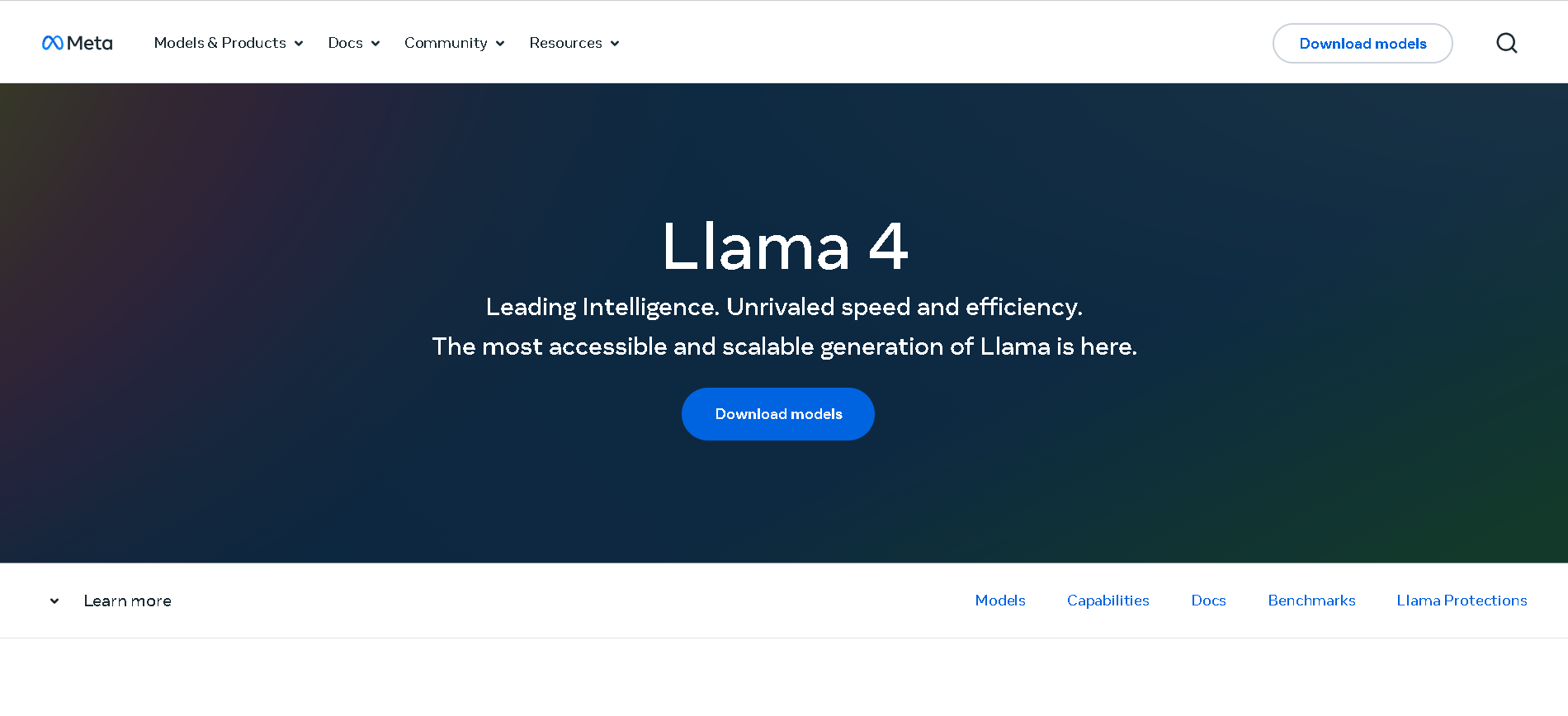
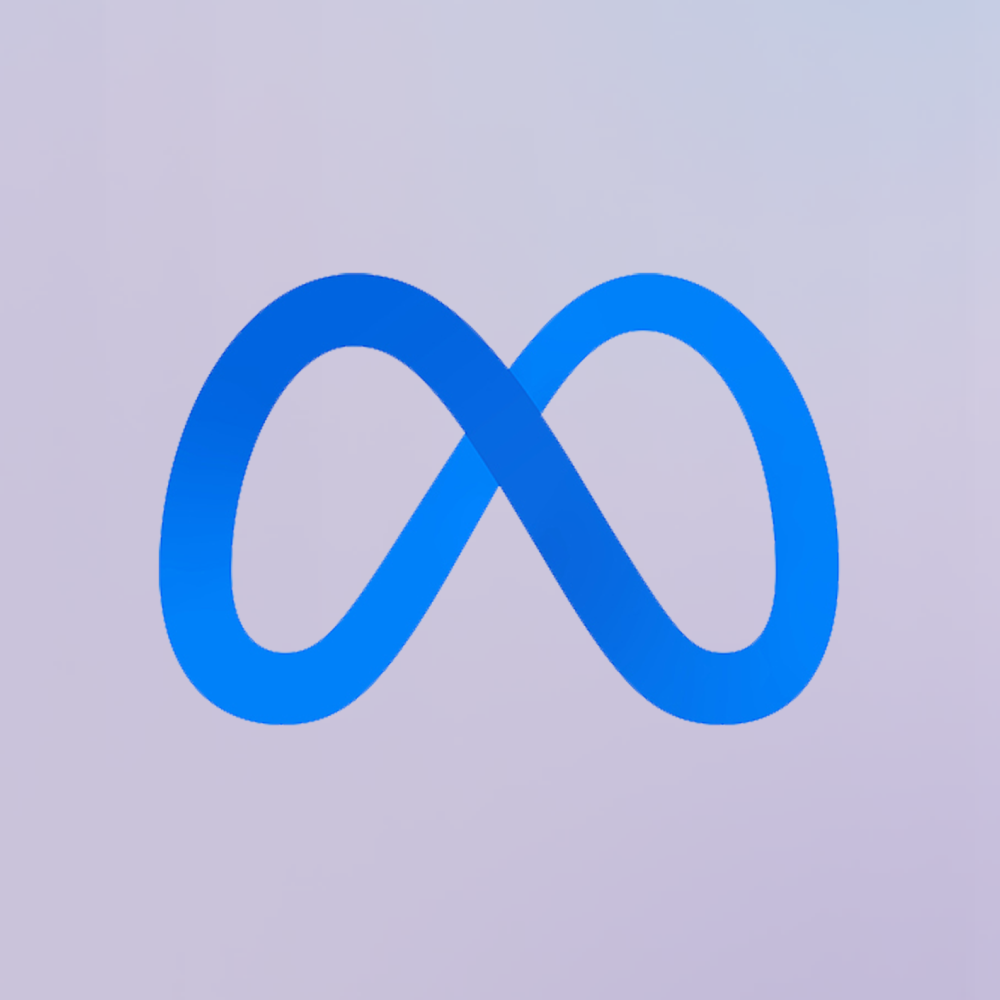
Meta Llama 4
Meta Llama 4 is the latest generation of Meta’s large language model series. It features a mixture-of-experts (MoE) architecture, making it both highly efficient and powerful. Llama 4 is natively multimodal—supporting text and image inputs—and offers three key variants: Scout (17B active parameters, 10 M token context), Maverick (17B active, 1 M token context), and Behemoth (288B active, 2 T total parameters; still in development). Designed for long-context reasoning, multilingual understanding, and open-weight availability (with license restrictions), Llama 4 excels in benchmarks and versatility.


Meta Llama 4
Meta Llama 4 is the latest generation of Meta’s large language model series. It features a mixture-of-experts (MoE) architecture, making it both highly efficient and powerful. Llama 4 is natively multimodal—supporting text and image inputs—and offers three key variants: Scout (17B active parameters, 10 M token context), Maverick (17B active, 1 M token context), and Behemoth (288B active, 2 T total parameters; still in development). Designed for long-context reasoning, multilingual understanding, and open-weight availability (with license restrictions), Llama 4 excels in benchmarks and versatility.


Meta Llama 4
Meta Llama 4 is the latest generation of Meta’s large language model series. It features a mixture-of-experts (MoE) architecture, making it both highly efficient and powerful. Llama 4 is natively multimodal—supporting text and image inputs—and offers three key variants: Scout (17B active parameters, 10 M token context), Maverick (17B active, 1 M token context), and Behemoth (288B active, 2 T total parameters; still in development). Designed for long-context reasoning, multilingual understanding, and open-weight availability (with license restrictions), Llama 4 excels in benchmarks and versatility.
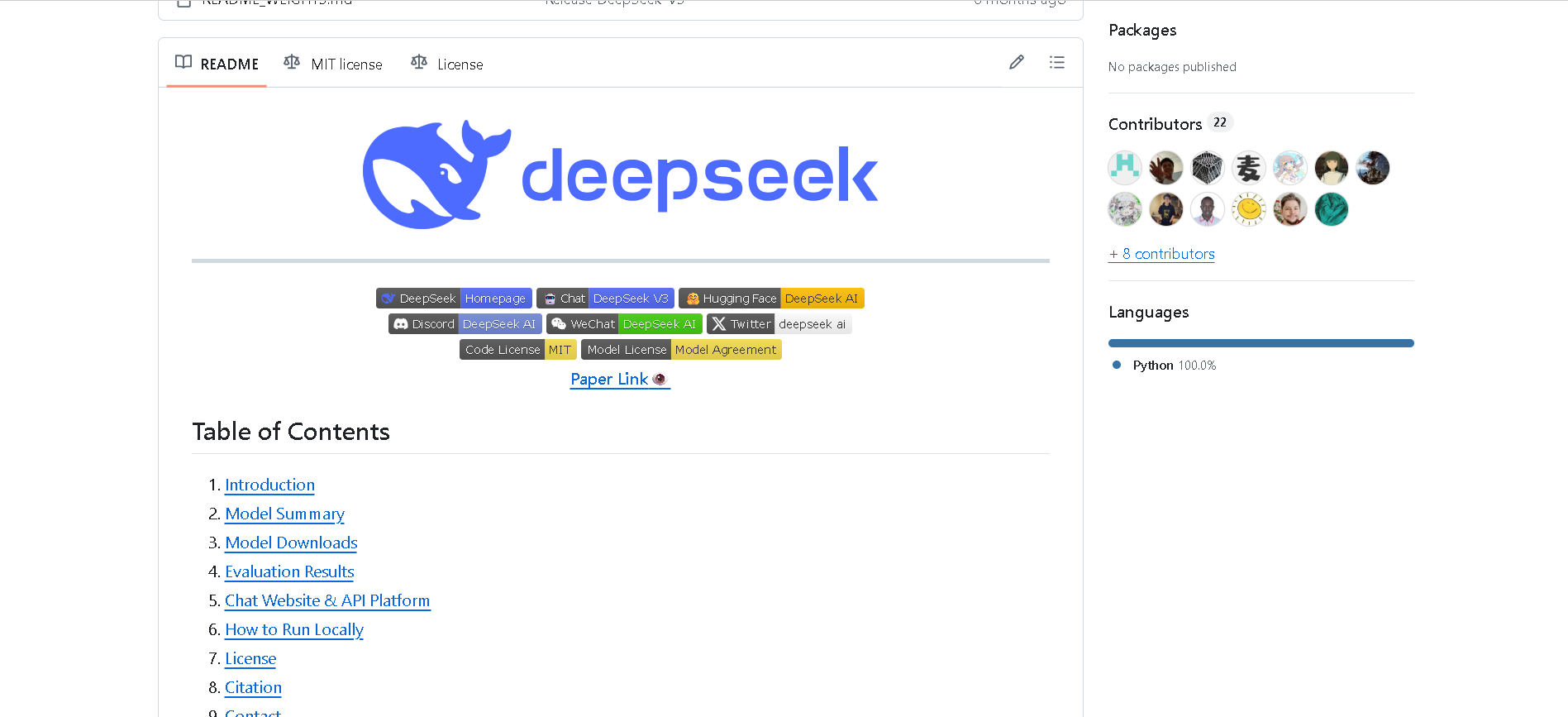
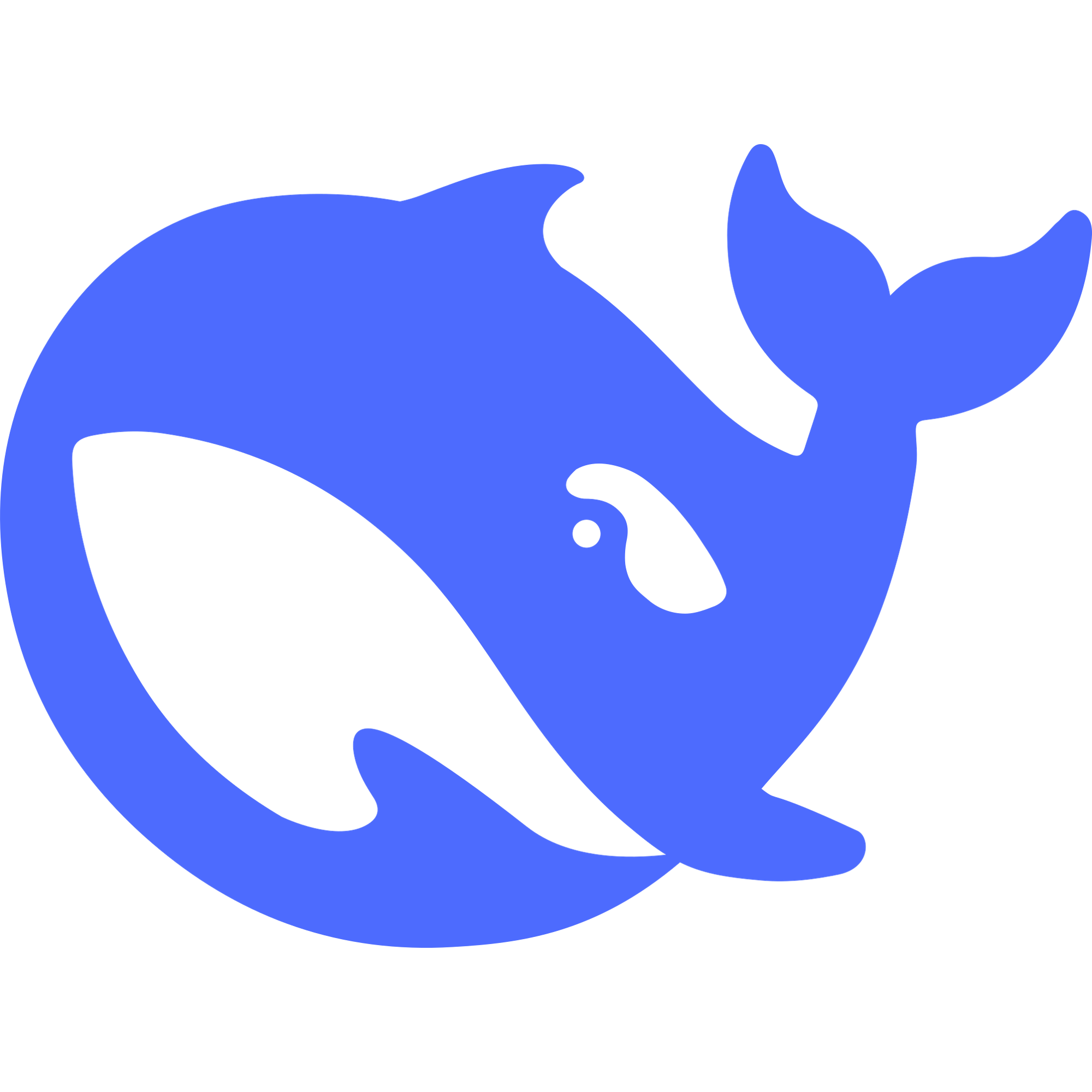
DeepSeek-V3
DeepSeek V3 is the latest flagship Mixture‑of‑Experts (MoE) open‑source AI model from DeepSeek. It features 671 billion total parameters (with ~37 billion activated per token), supports up to 128K context length, and excels across reasoning, code generation, language, and multimodal tasks. On standard benchmarks, it rivals or exceeds proprietary models—including GPT‑4o and Claude 3.5—as a high-performance, cost-efficient alternative.


DeepSeek-V3
DeepSeek V3 is the latest flagship Mixture‑of‑Experts (MoE) open‑source AI model from DeepSeek. It features 671 billion total parameters (with ~37 billion activated per token), supports up to 128K context length, and excels across reasoning, code generation, language, and multimodal tasks. On standard benchmarks, it rivals or exceeds proprietary models—including GPT‑4o and Claude 3.5—as a high-performance, cost-efficient alternative.


DeepSeek-V3
DeepSeek V3 is the latest flagship Mixture‑of‑Experts (MoE) open‑source AI model from DeepSeek. It features 671 billion total parameters (with ~37 billion activated per token), supports up to 128K context length, and excels across reasoning, code generation, language, and multimodal tasks. On standard benchmarks, it rivals or exceeds proprietary models—including GPT‑4o and Claude 3.5—as a high-performance, cost-efficient alternative.
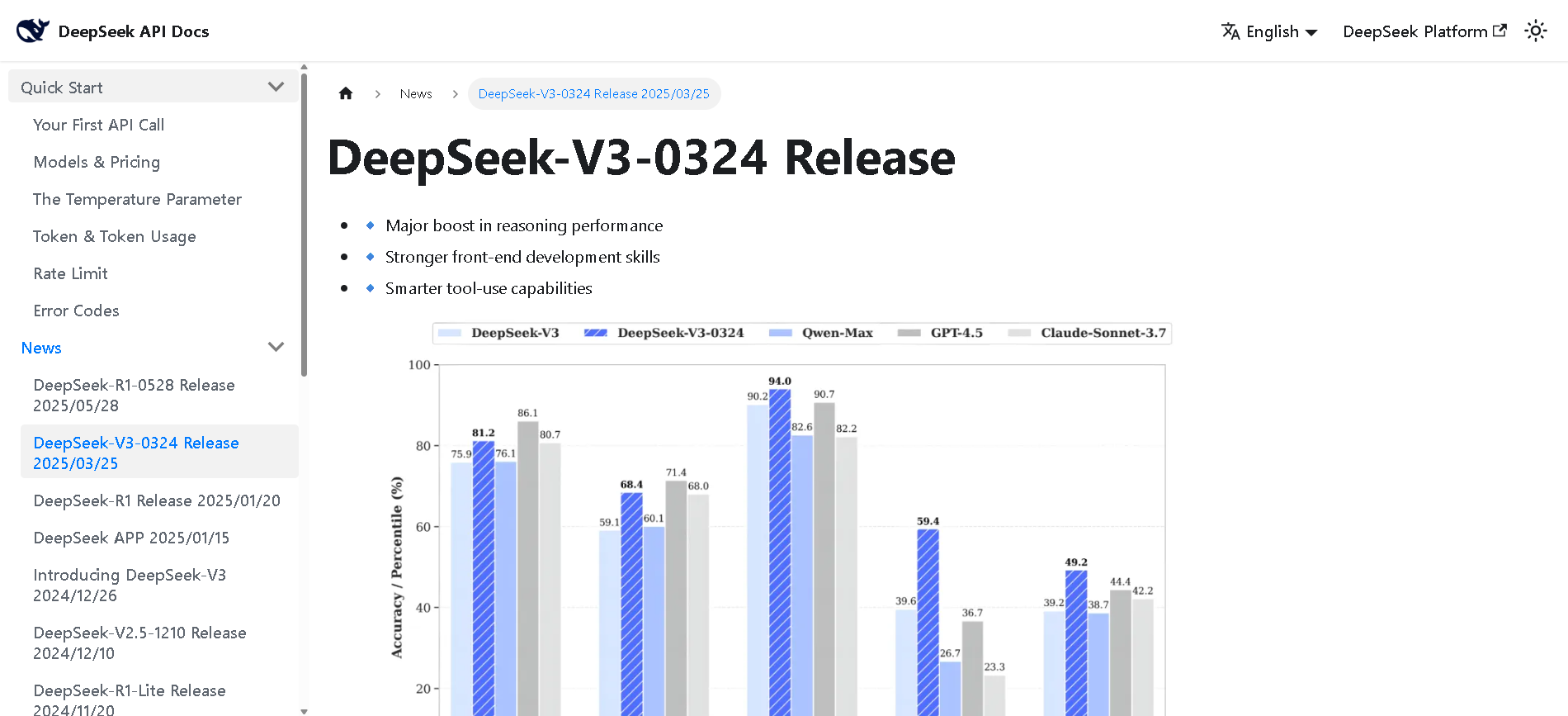
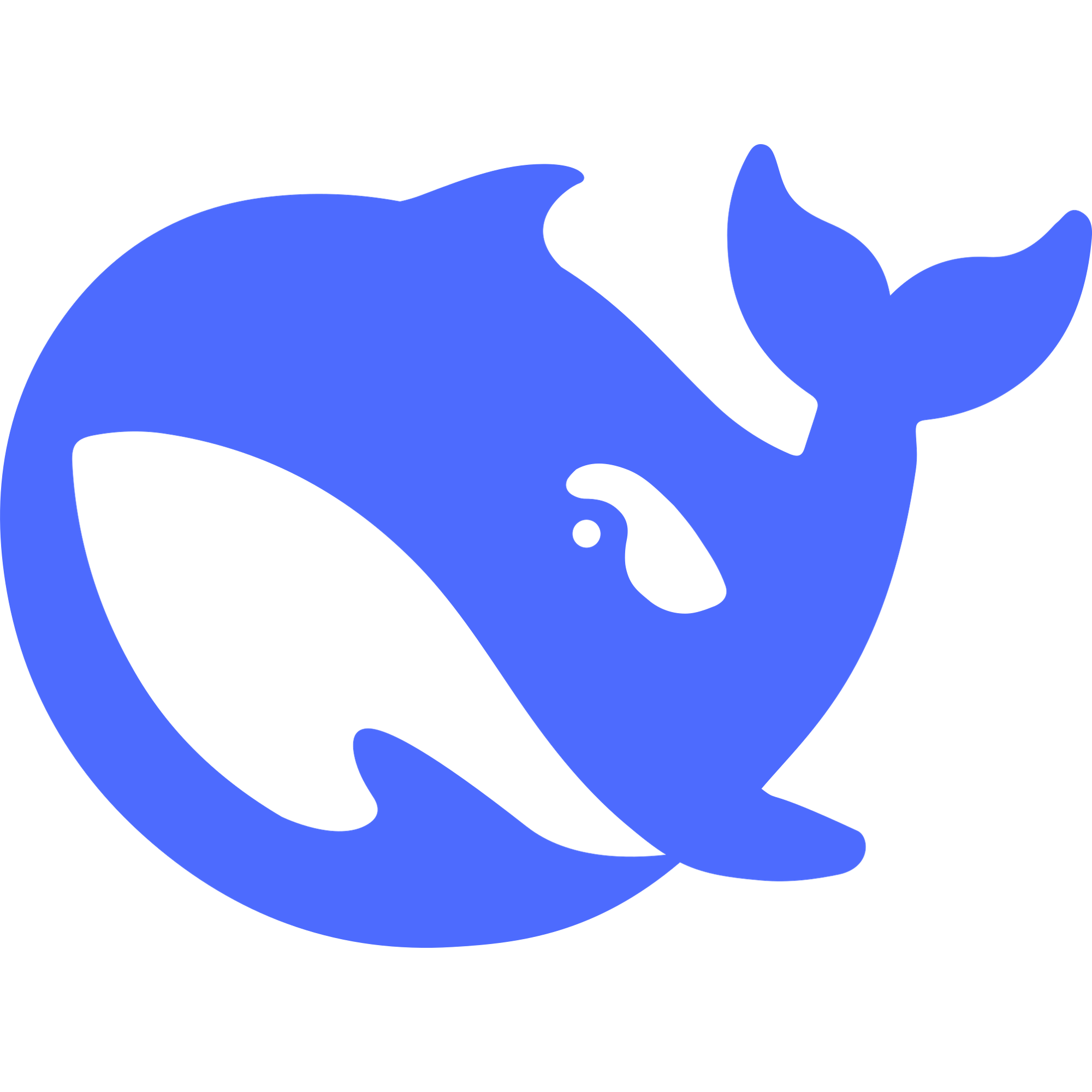
DeepSeek-V3-0324
DeepSeek V3 (0324) is the latest open-source Mixture-of-Experts (MoE) language model from DeepSeek, featuring 671B parameters (37B active per token). Released in March 2025 under the MIT license, it builds on DeepSeek V3 with major enhancements in reasoning, coding, front-end generation, and Chinese proficiency. It maintains cost-efficiency and function-calling support.


DeepSeek-V3-0324
DeepSeek V3 (0324) is the latest open-source Mixture-of-Experts (MoE) language model from DeepSeek, featuring 671B parameters (37B active per token). Released in March 2025 under the MIT license, it builds on DeepSeek V3 with major enhancements in reasoning, coding, front-end generation, and Chinese proficiency. It maintains cost-efficiency and function-calling support.


DeepSeek-V3-0324
DeepSeek V3 (0324) is the latest open-source Mixture-of-Experts (MoE) language model from DeepSeek, featuring 671B parameters (37B active per token). Released in March 2025 under the MIT license, it builds on DeepSeek V3 with major enhancements in reasoning, coding, front-end generation, and Chinese proficiency. It maintains cost-efficiency and function-calling support.
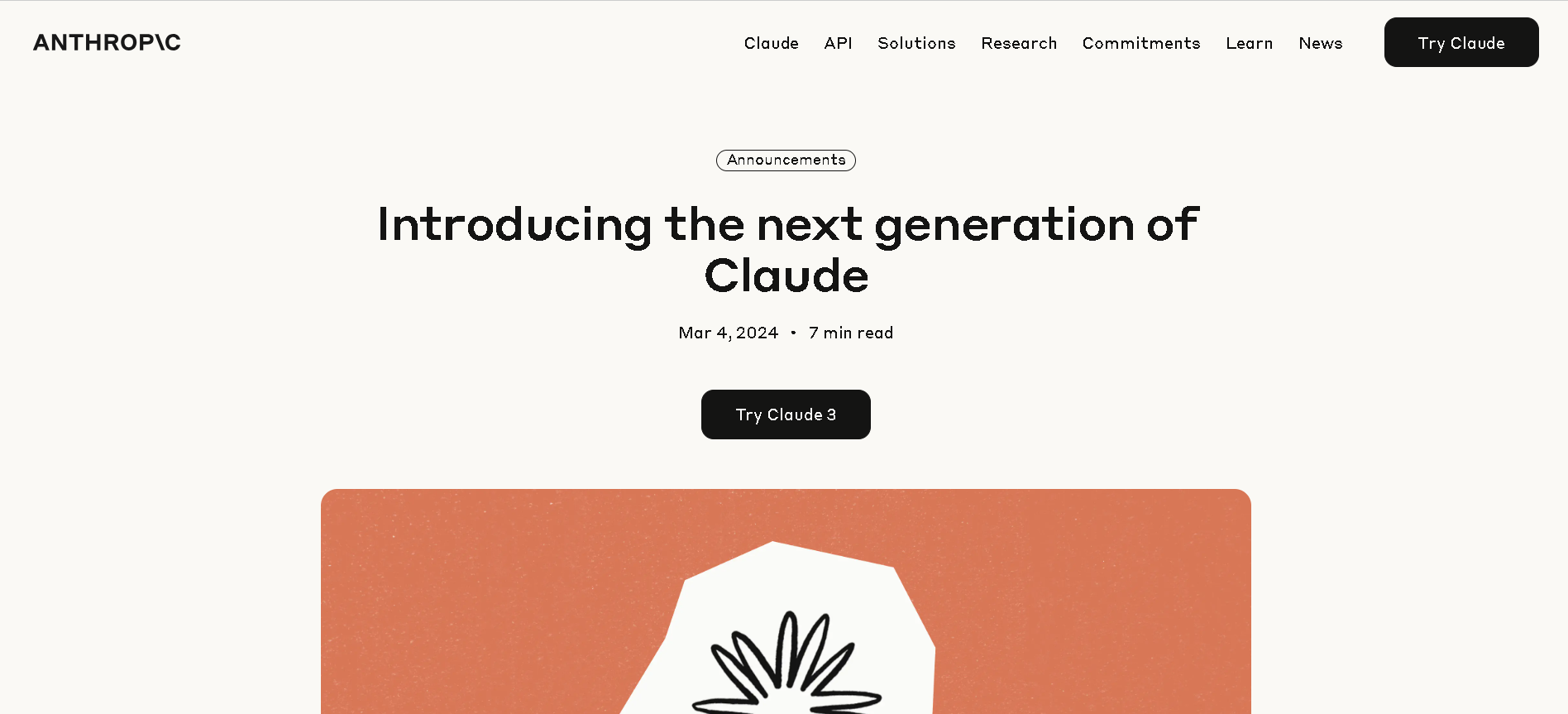

Claude 3 Opus
Claude 3 Opus is Anthropic’s flagship Claude 3 model, released March 4, 2024. It offers top-tier performance for deep reasoning, complex code, advanced math, and multimodal understanding—including charts and documents—supported by a 200K‑token context window (extendable to 1 million in select enterprise cases). It consistently outperforms GPT‑4 and Gemini Ultra on benchmark tests like MMLU, HumanEval, HellaSwag, and more.


Claude 3 Opus
Claude 3 Opus is Anthropic’s flagship Claude 3 model, released March 4, 2024. It offers top-tier performance for deep reasoning, complex code, advanced math, and multimodal understanding—including charts and documents—supported by a 200K‑token context window (extendable to 1 million in select enterprise cases). It consistently outperforms GPT‑4 and Gemini Ultra on benchmark tests like MMLU, HumanEval, HellaSwag, and more.


Claude 3 Opus
Claude 3 Opus is Anthropic’s flagship Claude 3 model, released March 4, 2024. It offers top-tier performance for deep reasoning, complex code, advanced math, and multimodal understanding—including charts and documents—supported by a 200K‑token context window (extendable to 1 million in select enterprise cases). It consistently outperforms GPT‑4 and Gemini Ultra on benchmark tests like MMLU, HumanEval, HellaSwag, and more.
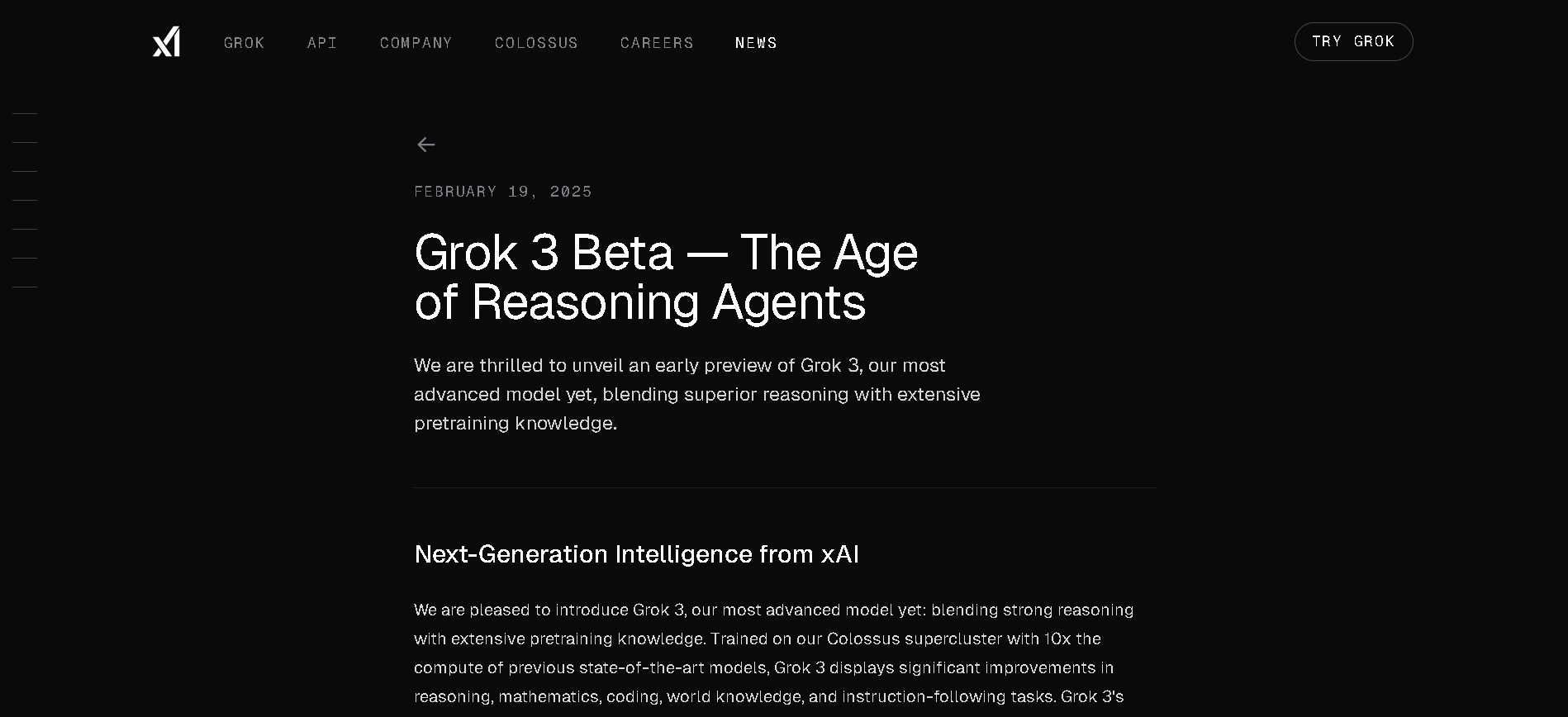
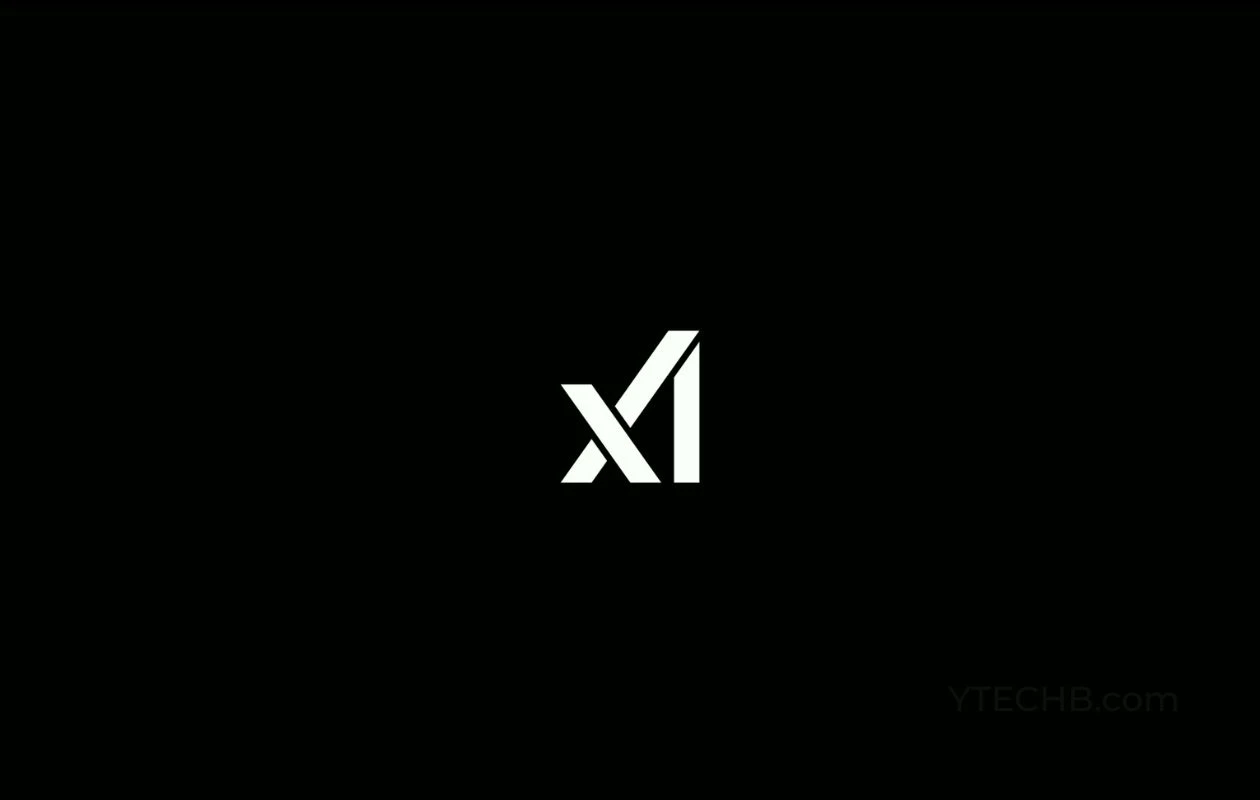
Grok 3 Latest
Grok 3 is xAI’s newest flagship AI chatbot, released on February 17, 2025, running on the massive Colossus supercluster (~200,000 GPUs). It offers elite-level reasoning, chain-of-thought transparency (“Think” mode), advanced “Big Brain” deeper reasoning, multimodal support (text, images), and integrated real-time DeepSearch—positioning it as a top-tier competitor to GPT‑4o, Gemini, Claude, and DeepSeek V3 on benchmarks.


Grok 3 Latest
Grok 3 is xAI’s newest flagship AI chatbot, released on February 17, 2025, running on the massive Colossus supercluster (~200,000 GPUs). It offers elite-level reasoning, chain-of-thought transparency (“Think” mode), advanced “Big Brain” deeper reasoning, multimodal support (text, images), and integrated real-time DeepSearch—positioning it as a top-tier competitor to GPT‑4o, Gemini, Claude, and DeepSeek V3 on benchmarks.


Grok 3 Latest
Grok 3 is xAI’s newest flagship AI chatbot, released on February 17, 2025, running on the massive Colossus supercluster (~200,000 GPUs). It offers elite-level reasoning, chain-of-thought transparency (“Think” mode), advanced “Big Brain” deeper reasoning, multimodal support (text, images), and integrated real-time DeepSearch—positioning it as a top-tier competitor to GPT‑4o, Gemini, Claude, and DeepSeek V3 on benchmarks.
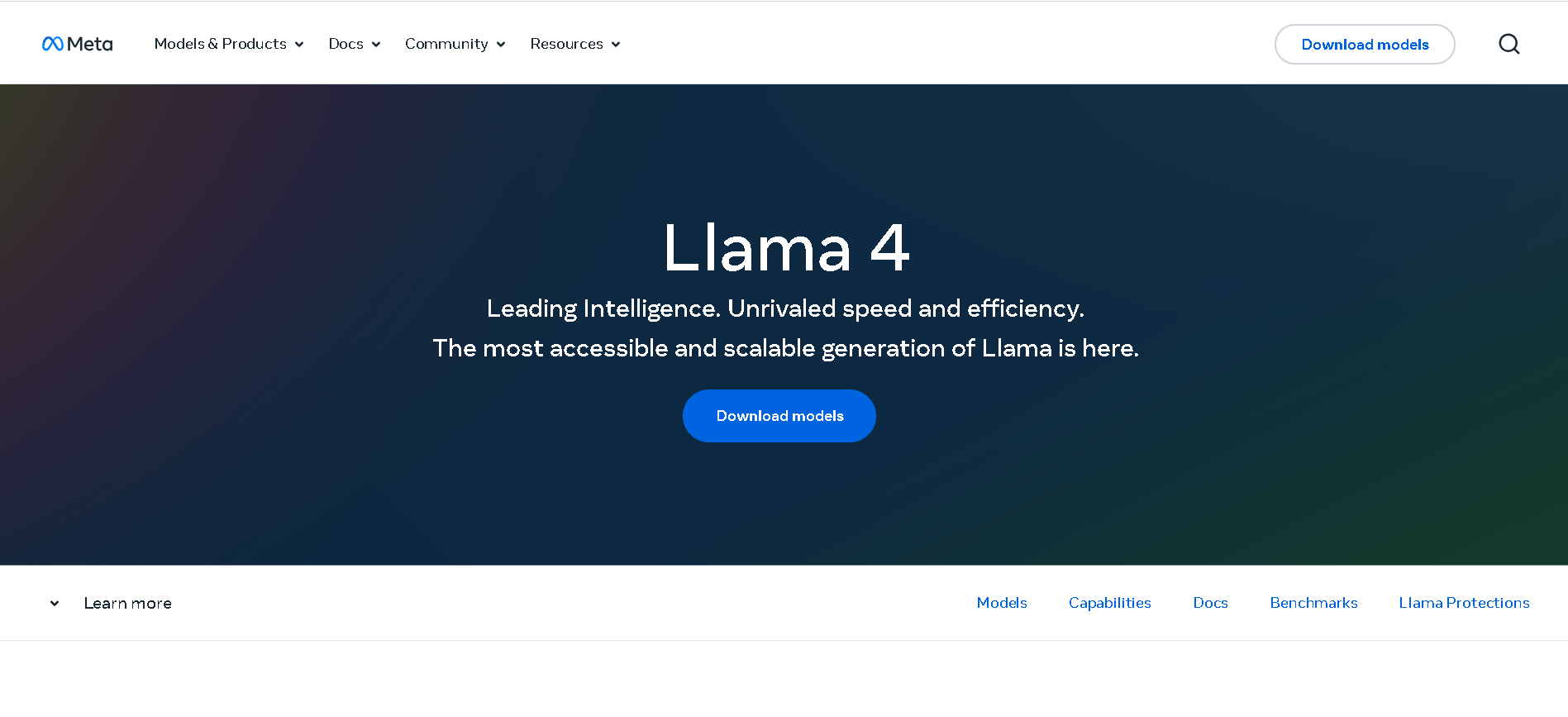

Meta Llama 4 Maver..
Llama 4 Maverick is Meta’s powerful mid-sized model in the Llama 4 series, released April 5, 2025. Built with a mixture-of-experts (MoE) architecture featuring 17 B active parameters (out of 400 B total) and 128 experts, it supports a 1 million-token context window and native multimodality for text and image inputs. It ranks near the top of competitive benchmarks—surpassing GPT‑4o and Gemini 2.0 Flash in reasoning, coding, and visual tasks.


Meta Llama 4 Maver..
Llama 4 Maverick is Meta’s powerful mid-sized model in the Llama 4 series, released April 5, 2025. Built with a mixture-of-experts (MoE) architecture featuring 17 B active parameters (out of 400 B total) and 128 experts, it supports a 1 million-token context window and native multimodality for text and image inputs. It ranks near the top of competitive benchmarks—surpassing GPT‑4o and Gemini 2.0 Flash in reasoning, coding, and visual tasks.


Meta Llama 4 Maver..
Llama 4 Maverick is Meta’s powerful mid-sized model in the Llama 4 series, released April 5, 2025. Built with a mixture-of-experts (MoE) architecture featuring 17 B active parameters (out of 400 B total) and 128 experts, it supports a 1 million-token context window and native multimodality for text and image inputs. It ranks near the top of competitive benchmarks—surpassing GPT‑4o and Gemini 2.0 Flash in reasoning, coding, and visual tasks.
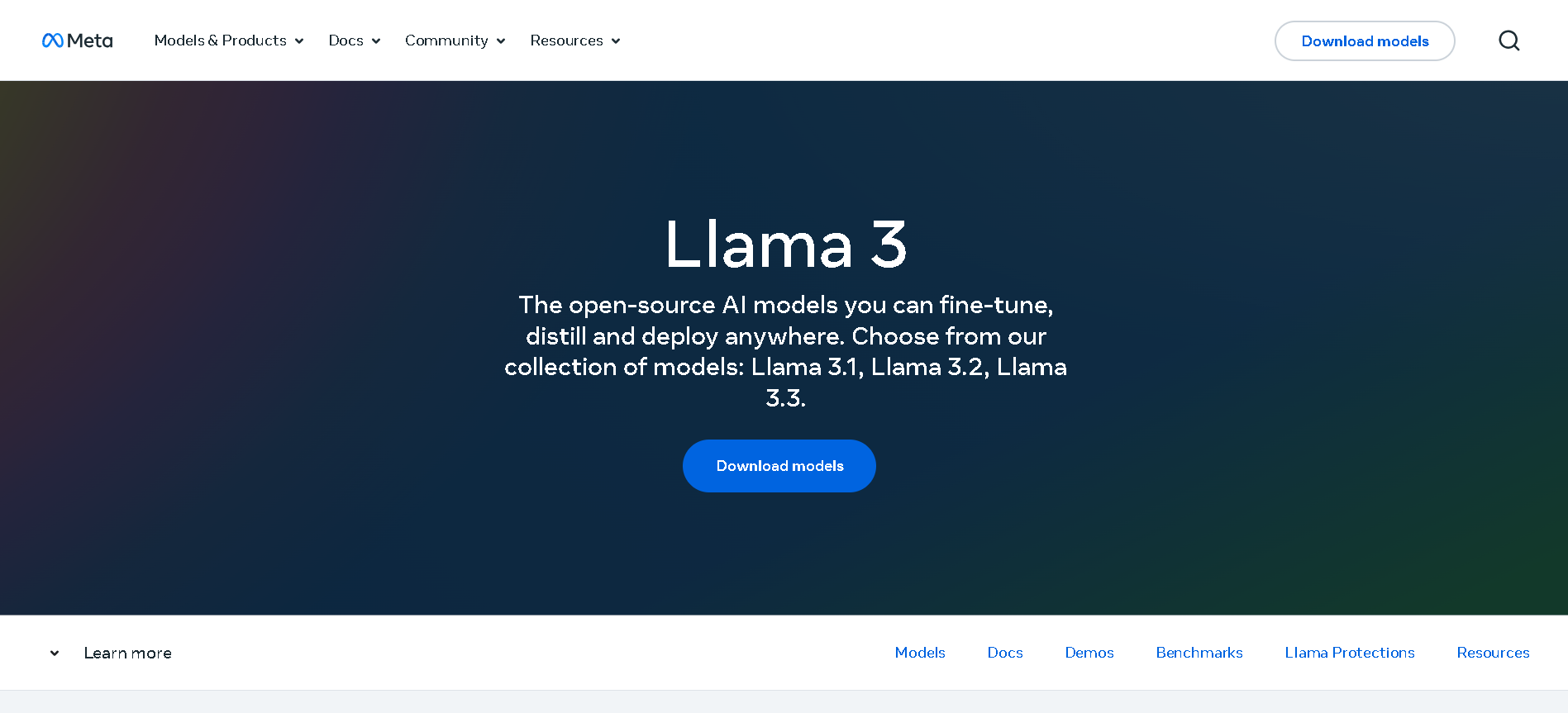

Meta Llama 3.1
Llama 3.1 is Meta’s most advanced open-source Llama 3 model, released on July 23, 2024. It comes in three sizes—8B, 70B, and 405B parameters—with an expanded 128K-token context window and improved multilingual and multimodal capabilities. It significantly outperforms Llama 3 and rivals proprietary models across benchmarks like GSM8K, MMLU, HumanEval, ARC, and tool-augmented reasoning tasks.


Meta Llama 3.1
Llama 3.1 is Meta’s most advanced open-source Llama 3 model, released on July 23, 2024. It comes in three sizes—8B, 70B, and 405B parameters—with an expanded 128K-token context window and improved multilingual and multimodal capabilities. It significantly outperforms Llama 3 and rivals proprietary models across benchmarks like GSM8K, MMLU, HumanEval, ARC, and tool-augmented reasoning tasks.


Meta Llama 3.1
Llama 3.1 is Meta’s most advanced open-source Llama 3 model, released on July 23, 2024. It comes in three sizes—8B, 70B, and 405B parameters—with an expanded 128K-token context window and improved multilingual and multimodal capabilities. It significantly outperforms Llama 3 and rivals proprietary models across benchmarks like GSM8K, MMLU, HumanEval, ARC, and tool-augmented reasoning tasks.
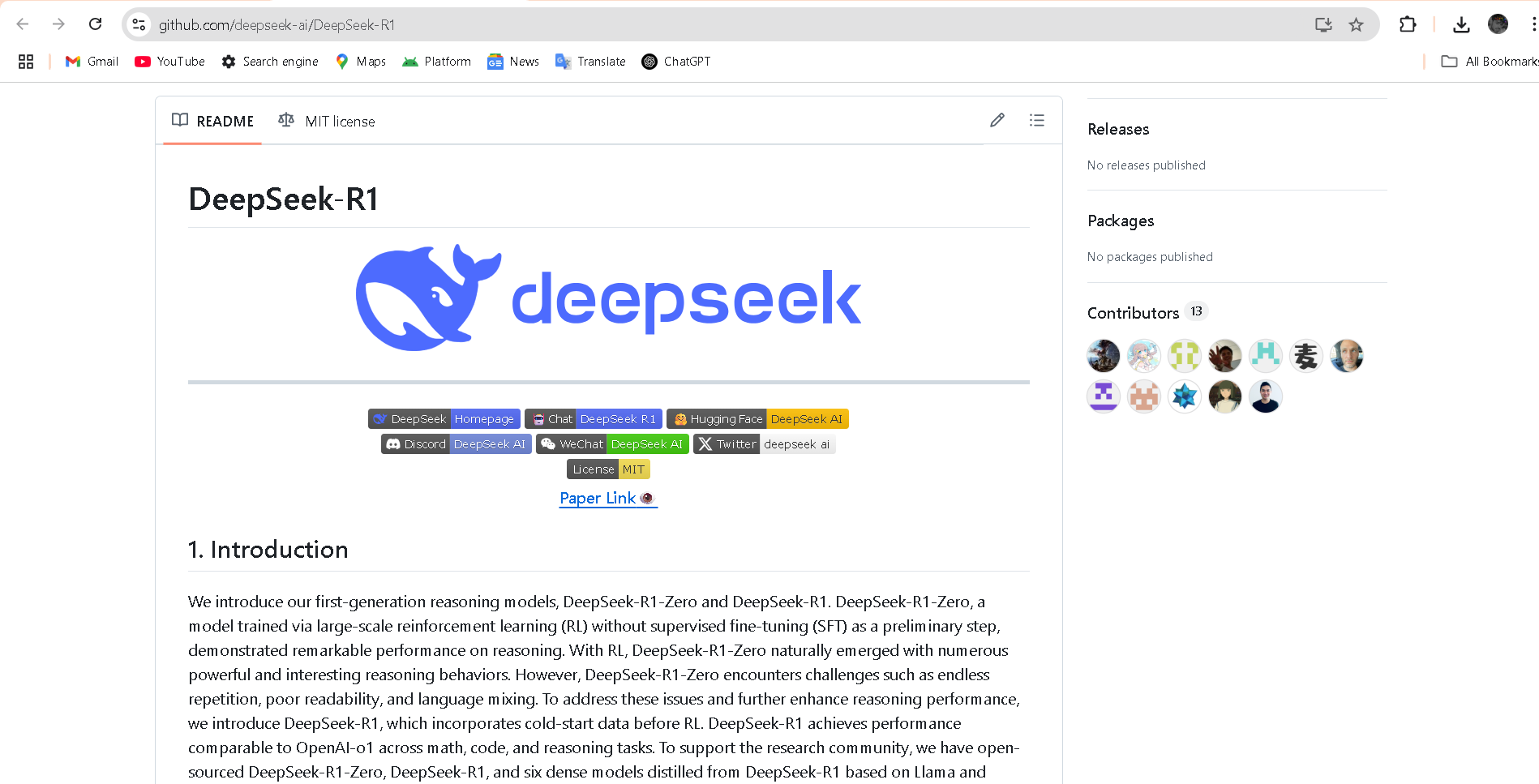
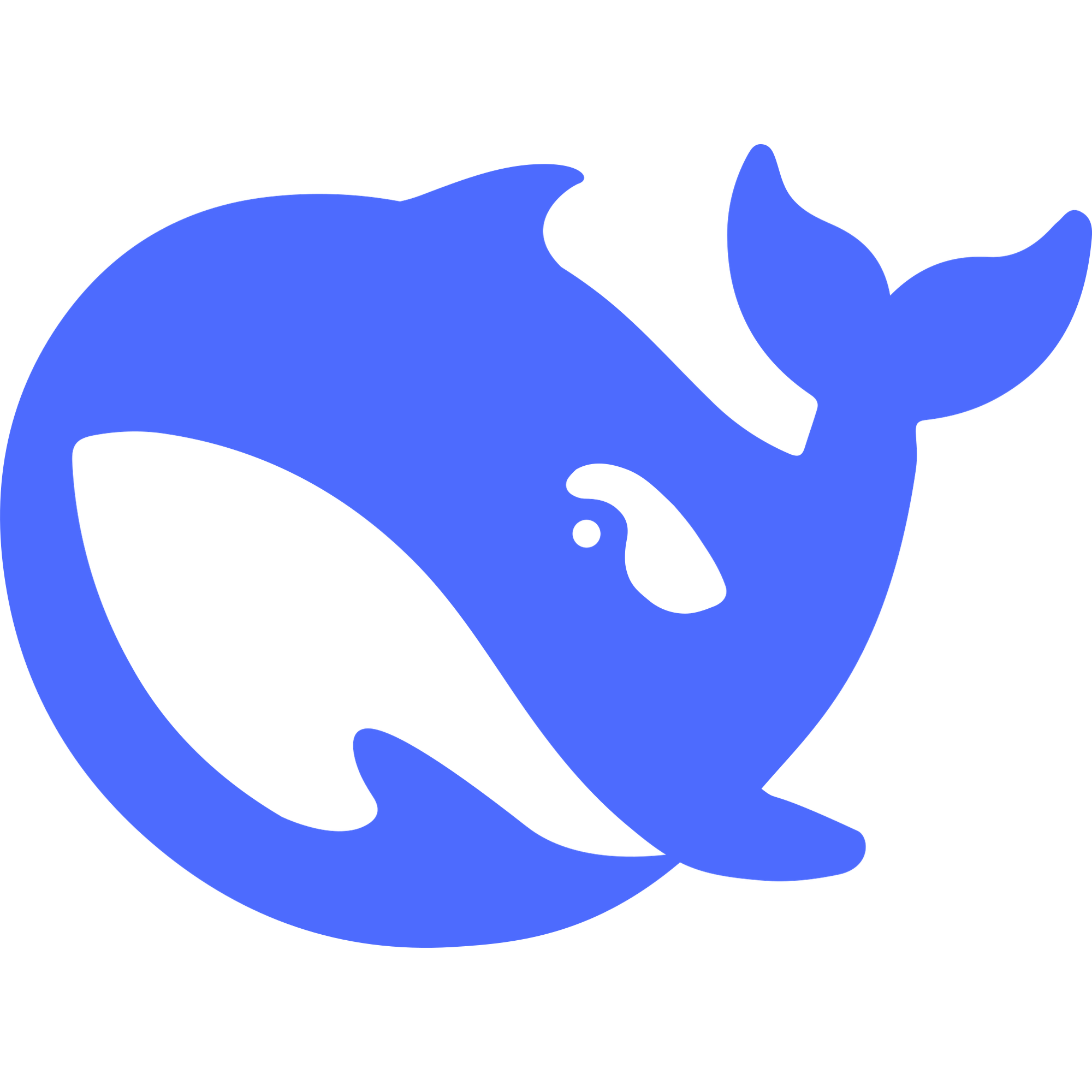
DeepSeek-R1-Zero
DeepSeek R1 Zero is an open-source large language model introduced in January 2025 by DeepSeek AI. It is a reinforcement learning–only version of DeepSeek R1, trained without supervised fine-tuning. With 671B total parameters (37B active) and a 128K-token context window, it demonstrates strong chain-of-thought reasoning, self-verification, and reflection.


DeepSeek-R1-Zero
DeepSeek R1 Zero is an open-source large language model introduced in January 2025 by DeepSeek AI. It is a reinforcement learning–only version of DeepSeek R1, trained without supervised fine-tuning. With 671B total parameters (37B active) and a 128K-token context window, it demonstrates strong chain-of-thought reasoning, self-verification, and reflection.


DeepSeek-R1-Zero
DeepSeek R1 Zero is an open-source large language model introduced in January 2025 by DeepSeek AI. It is a reinforcement learning–only version of DeepSeek R1, trained without supervised fine-tuning. With 671B total parameters (37B active) and a 128K-token context window, it demonstrates strong chain-of-thought reasoning, self-verification, and reflection.
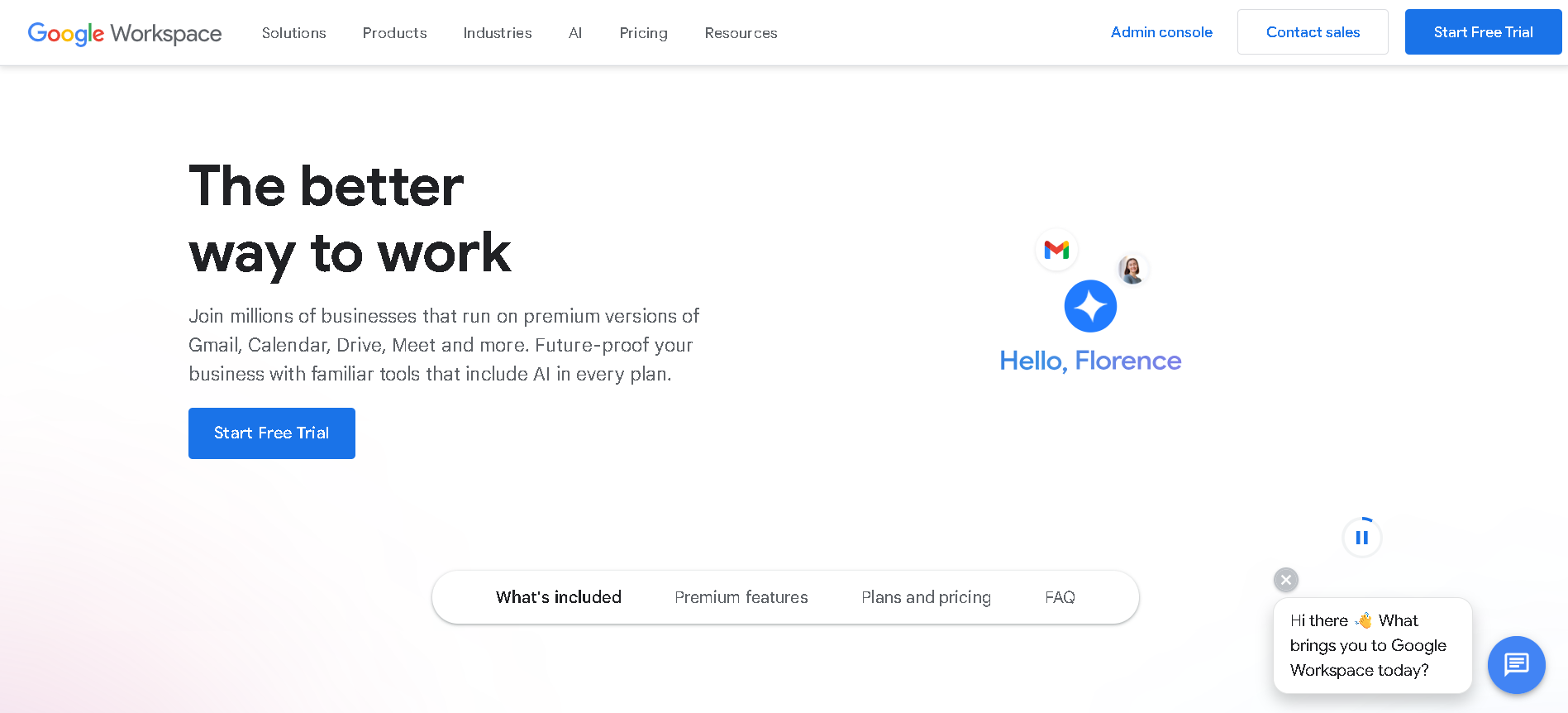

Google Workspace A..
Google Workspace AI (also known as "Gemini in Workspace") is Google’s integrated suite of AI-powered features embedded throughout Gmail, Docs, Sheets, Slides, Meet, Chat, Drive, Vids, Forms, and more. Introduced fully in early 2025, it brings Gemini 2.5 Pro, NotebookLM Plus, agentic workflows via Workspace Flows, and domain-specific video editing to help businesses and educators work smarter and faster.


Google Workspace A..
Google Workspace AI (also known as "Gemini in Workspace") is Google’s integrated suite of AI-powered features embedded throughout Gmail, Docs, Sheets, Slides, Meet, Chat, Drive, Vids, Forms, and more. Introduced fully in early 2025, it brings Gemini 2.5 Pro, NotebookLM Plus, agentic workflows via Workspace Flows, and domain-specific video editing to help businesses and educators work smarter and faster.


Google Workspace A..
Google Workspace AI (also known as "Gemini in Workspace") is Google’s integrated suite of AI-powered features embedded throughout Gmail, Docs, Sheets, Slides, Meet, Chat, Drive, Vids, Forms, and more. Introduced fully in early 2025, it brings Gemini 2.5 Pro, NotebookLM Plus, agentic workflows via Workspace Flows, and domain-specific video editing to help businesses and educators work smarter and faster.
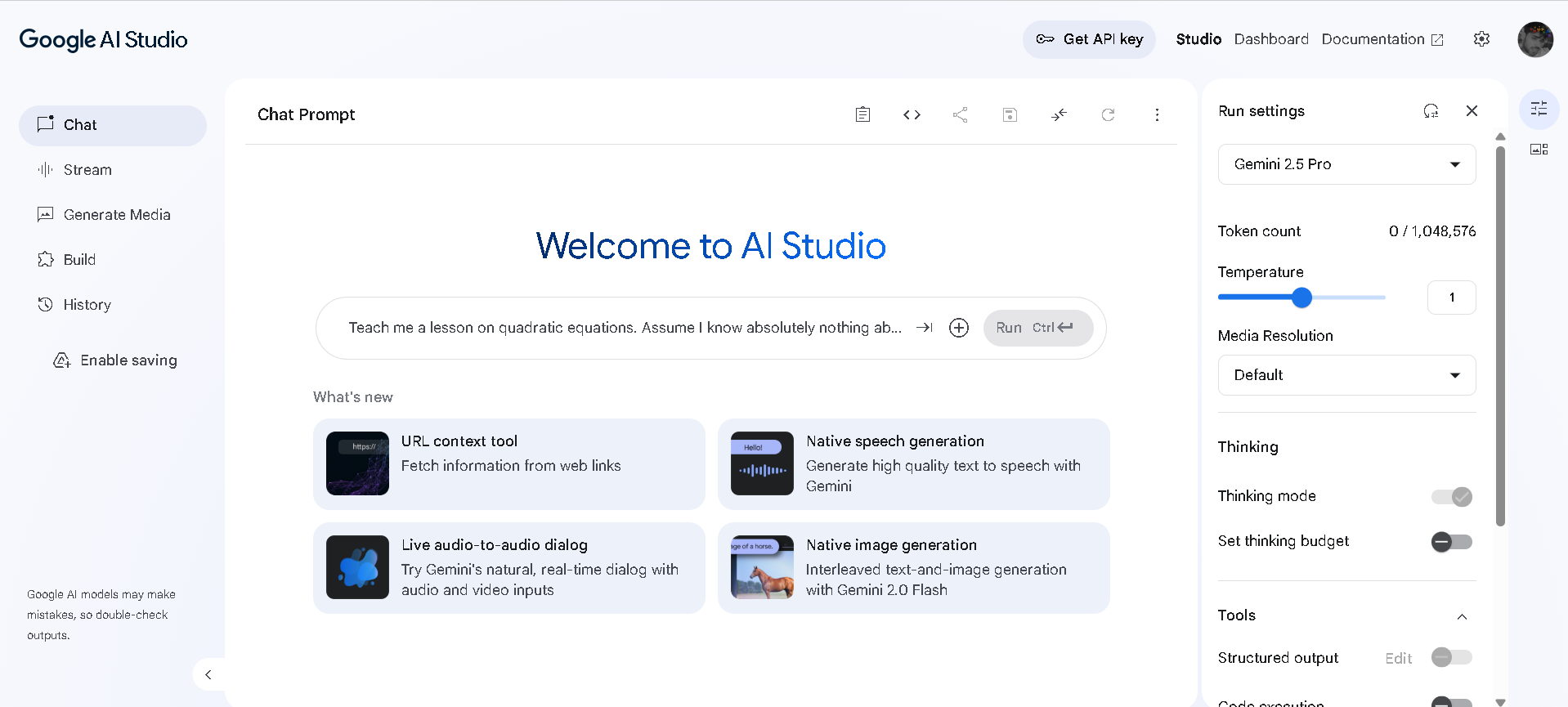

Google AI Studio
Google AI Studio is a web-based development environment that allows users to explore, prototype, and build applications using Google's cutting-edge generative AI models, such as Gemini. It provides a comprehensive set of tools for interacting with AI through chat prompts, generating various media types, and fine-tuning model behaviors for specific use cases.


Google AI Studio
Google AI Studio is a web-based development environment that allows users to explore, prototype, and build applications using Google's cutting-edge generative AI models, such as Gemini. It provides a comprehensive set of tools for interacting with AI through chat prompts, generating various media types, and fine-tuning model behaviors for specific use cases.


Google AI Studio
Google AI Studio is a web-based development environment that allows users to explore, prototype, and build applications using Google's cutting-edge generative AI models, such as Gemini. It provides a comprehensive set of tools for interacting with AI through chat prompts, generating various media types, and fine-tuning model behaviors for specific use cases.
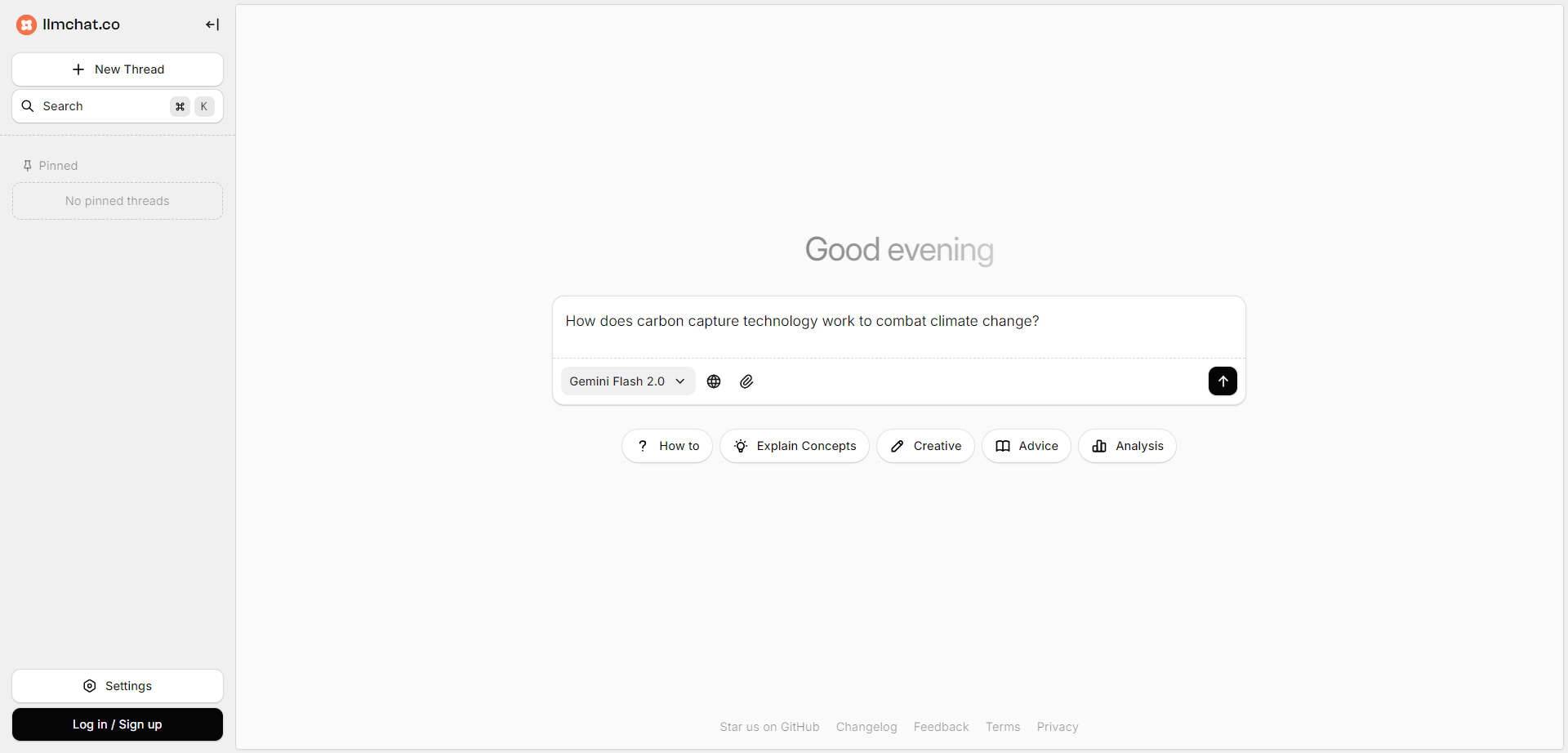
LLM Chat
LLMChat is a privacy-focused, open-source AI chatbot platform designed for advanced research, agentic workflows, and seamless interaction with multiple large language models (LLMs). It offers users a minimalistic and intuitive interface enabling deep exploration of complex topics with modes like Deep Research and Pro Search, which incorporates real-time web integration for current data. The platform emphasizes user privacy by storing all chat history locally in the browser, ensuring conversations never leave the device. LLMChat supports many popular LLM providers such as OpenAI, Anthropic, Google, and more, allowing users to customize AI assistants with personalized instructions and knowledge bases for a wide variety of applications ranging from research to content generation and coding assistance.

LLM Chat
LLMChat is a privacy-focused, open-source AI chatbot platform designed for advanced research, agentic workflows, and seamless interaction with multiple large language models (LLMs). It offers users a minimalistic and intuitive interface enabling deep exploration of complex topics with modes like Deep Research and Pro Search, which incorporates real-time web integration for current data. The platform emphasizes user privacy by storing all chat history locally in the browser, ensuring conversations never leave the device. LLMChat supports many popular LLM providers such as OpenAI, Anthropic, Google, and more, allowing users to customize AI assistants with personalized instructions and knowledge bases for a wide variety of applications ranging from research to content generation and coding assistance.

LLM Chat
LLMChat is a privacy-focused, open-source AI chatbot platform designed for advanced research, agentic workflows, and seamless interaction with multiple large language models (LLMs). It offers users a minimalistic and intuitive interface enabling deep exploration of complex topics with modes like Deep Research and Pro Search, which incorporates real-time web integration for current data. The platform emphasizes user privacy by storing all chat history locally in the browser, ensuring conversations never leave the device. LLMChat supports many popular LLM providers such as OpenAI, Anthropic, Google, and more, allowing users to customize AI assistants with personalized instructions and knowledge bases for a wide variety of applications ranging from research to content generation and coding assistance.
Editorial Note
This page was researched and written by the ATB Editorial Team. Our team researches each AI tool by reviewing its official website, testing features, exploring real use cases, and considering user feedback. Every page is fact-checked and regularly updated to ensure the information stays accurate, neutral, and useful for our readers.
If you have any suggestions or questions, email us at hello@aitoolbook.ai
